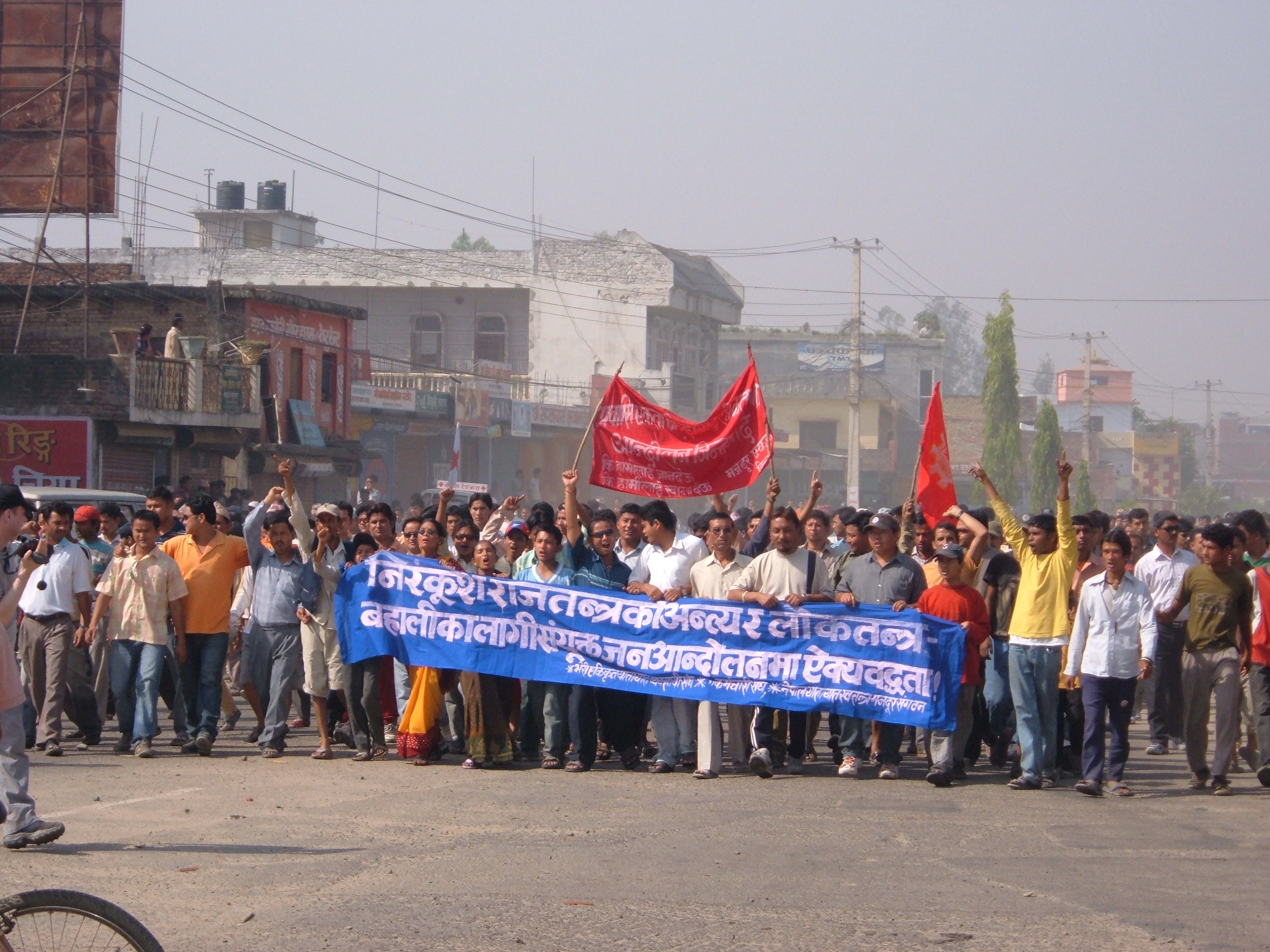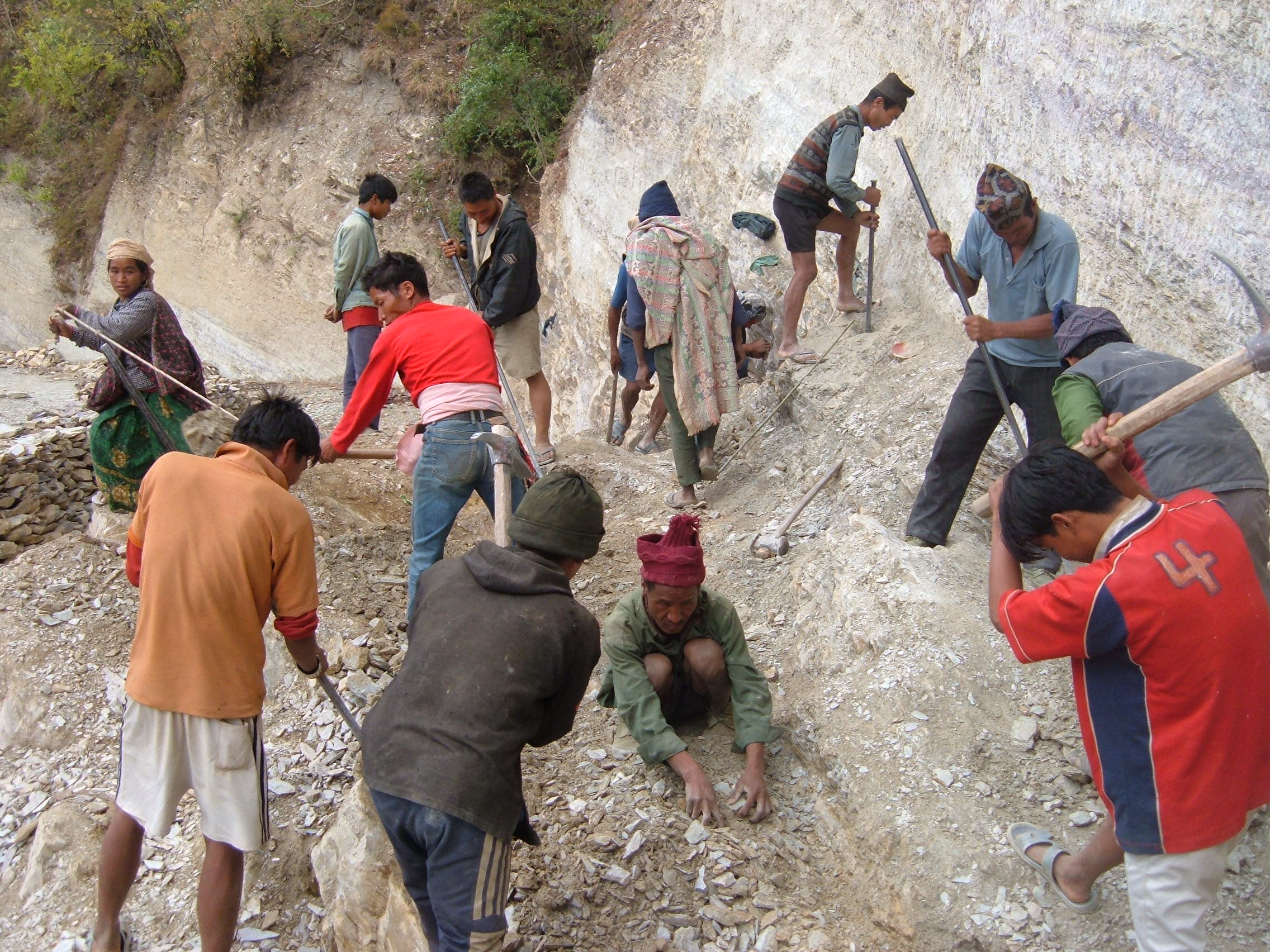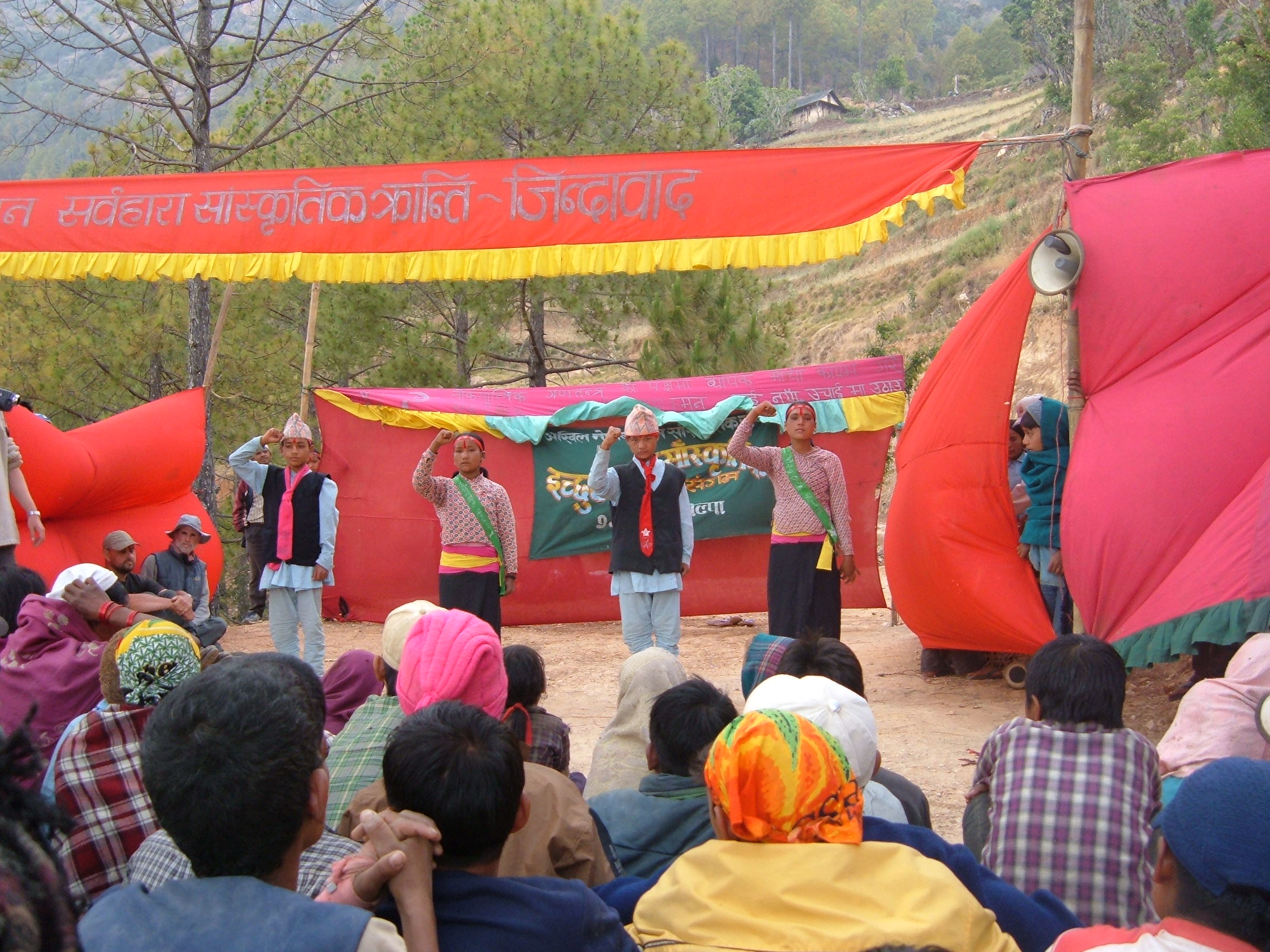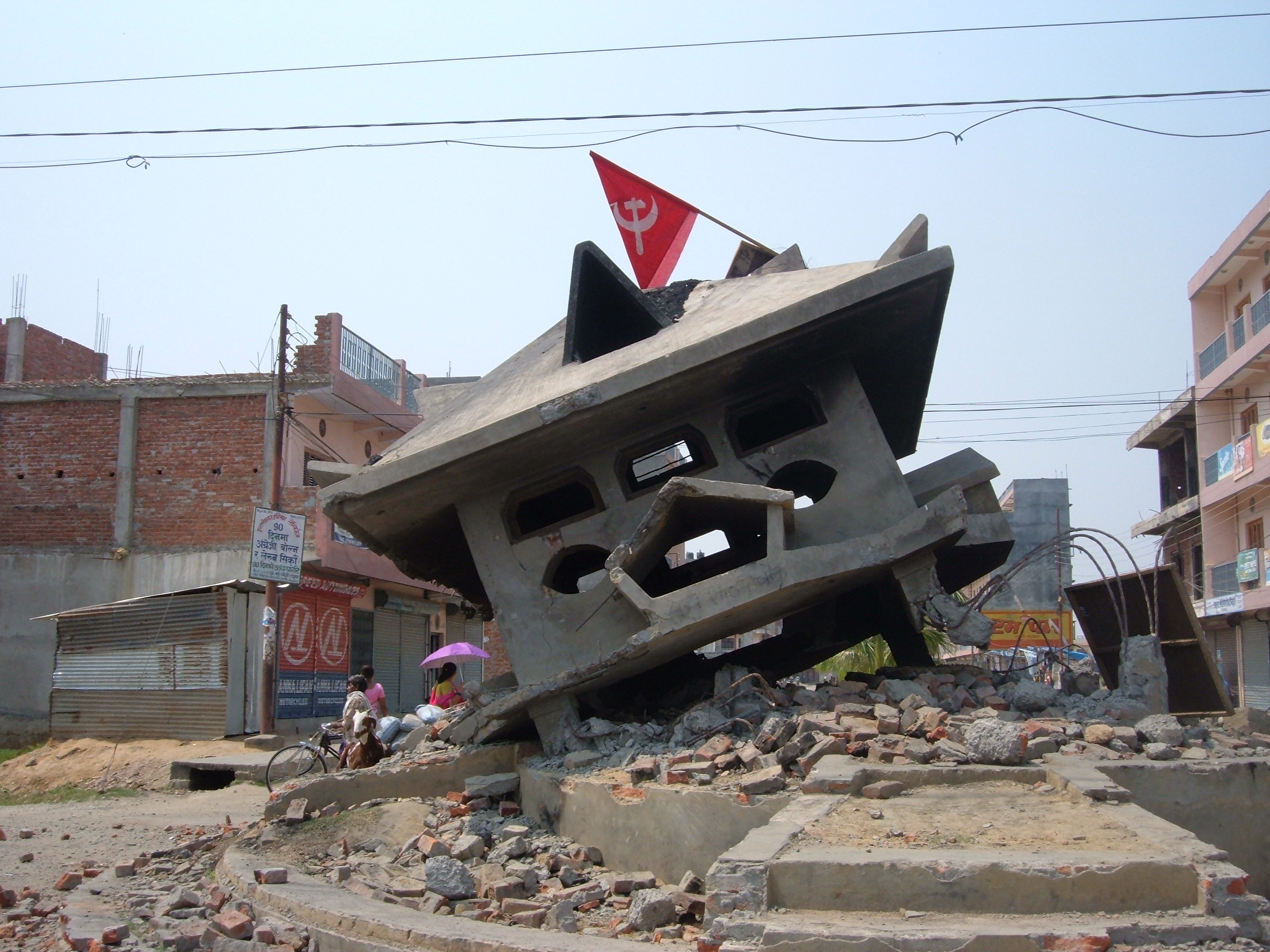A Road to the Future - International Brigade visit to Nepal
Jerome King | 04.07.2006 17:28 | Social Struggles | World
We were in Nepal for three weeks during April 2006, at the height of the People's Movement. Our experience included the general strike, the daily protests in medium sized cities where there were no other westerners, and a visit to a Maoist held "liberated base area". Indeed, from the beginning we aimed to get to this base area but were held up because there were no vehicles on the roads during the strike. In the end, we cycled 150kms and then walked into the mountains to reach our destination.
(Britain and Ireland representatives)
As the Nepalese people’s struggle against the autocratic feudal monarchy to establish a democratic republic hit a high point during the month of April, it coincided with the arrival from India of the Second International Road-Building Brigade. While the old oppressive and exploitative feudalist world was being attacked and dismantled in the country’s towns and cities, the challenge of building the new people’s republic was continuing in the liberated base areas of the CPN(M). An important element in this in recent times has been the construction of 91 kilometres of what is known as the Martyrs Road. Organised by the people-elected Magarat Autonomous People’s Republican Government in the main base area, mass organisations have been engaged in building what is a motorable road, the moral and material support of the masses helping to create the infrastructure of the new people’s society. The Second International Road Building Brigade, drawing its members from Afghanistan, Iran, Scotland and England was gathered with the aim of journeying to Rolpa during April to work on this road.
As the group met up in Nepalgunj, the situation at that time in Nepal saw the country in the grip of nation-wide, anti-monarchist protests and a bandh (shutdown) that not only closed all the shops and commercial outlets but also cleared all motor vehicles from the roads. Trapped in Nepalgunj therefore, across the border from India, we were ideally placed to witness one of the many anti-monarchist protests outside of Kathmandu. A major focus for mass anger was Gyanendra Square, the central monument dedicated to the king. This monument was given 24-hour paramilitary police protection but was still a focus point for the protestors. On our second day in Nepalganj from a distance we saw smoke billowing in the sky above the monument. One man walked past us and motioned for us to take photos, another shouted “hello, namaste, we want democracy okay!” As we approached the monument a crowd of around 100 people had gathered and more police had arrived on the scene. Four piles of tires had been set on fire around the monument, causing the whole monument to the king to be surrounded in smoke. We were all amazed at the audacity of the action, considering the paramilitary guard, especially while the April Movement was only days old. Indeed, there was more to come for the monument to King Gyanendra!
As well as the fires, there were numerous demonstrations throughout the day, every day. Containing large numbers of women, these protests drew many from the Hindu, Muslim and Christian communities. As well as workers, peasants and students, civil servants, including doctors, lawyers, teachers and bank officials marched through the streets. At most of the intersections, the remains of burning tyres were a constant feature, new fires breaking out at regular intervals. The slogans chanted by the protestors left little room for reconciliation. As one of these marches approached the statue of Gyanendra’s deeply unpopular grandfather, Tribhuvan, a man with a loudhailer called out, “What does Arayghat want?” the crowd responding with, “Arayghat wants Gyanendra”. Arayghat is the royal cemetery, where it seemed many protestors wanted King Gyanendra to end up sooner rather than later! Also popular was the call to “Hang Paras from a tree”. Gyanendra’s son, Prince Paras is also much hated as a man who has committed both rape and murder but who has proved immune from legal action. These minor protests, the crowds becoming increasingly antagonistic, were set to rise in both numbers and militancy as the campaign intensified and tens of thousands of protestors poured into the cities from the countryside. In its early days however, it was still not strong enough to overpower the armed police, and we witnessed a standoff as the demonstrators wanted to destroy the monument to the King but were not strong enough to break the police lines.
This People’s Movement was distinctly anti-monarchy, retaining a general line of being anti-Congress due to the Nepali Congress party being perceived as both too close to the monarchy and renowned for its corruption and its inefficiency in previous governments. Most of the protestors by far appeared to be in favour of a republic, this being recognised as a more modern form of government in contrast to the existing feudal autocracy. Many of those that we talked to, spoke of achieving a British-style constitutional monarchy, although the cultivation of a constituent assembly and a republic were infinitely more popular. Indeed, while trying to maintain that we were tourists inadvertently caught up in the People’s Movement (because we didn’t want to do anything that would endanger our attempts to get to the liberated zones), we also tried to struggle with some Nepali people about the nature of society in Britain – what they described as “the mother of democracy” – trying to let them understand the role of Britain within the capitalist system of exploitation and the real lack of ‘democracy’ and ‘freedom’ in our country!
“If the SPA fails to move towards a constituent assembly,
then the people will protest again.”
There was however, also some concern among the protestors that the Seven Party Alliance leadership would compromise with the monarchy allowing the people’s demand for a democratic republic to fall short. One man said to us that “if the SPA fails to move towards a constituent assembly, then the people will protest again.” Within these protesting crowds, it was acknowledged that the Maoists were very much a part of the peoples’ struggle and therefore part of the democratic agenda. We witnessed constant flows of people coming from the Maoist controlled base areas, and the tractors and trailers that waited outside the city to take them home, which strengthened the movement in the cities. In this way, the protests in the towns and cities tended to increase by tens of thousands as the campaign escalated.
After our work brigade had left, we were told on returning to Nepalganj, by people that had been there, that the movement had grown rapidly. The main protest is reported to have consisted of 60-100,000 people – not bad for a city with a population of around 60,000! In this major demonstration, the crowds once again focused their anger against the monument to King Gyanendra. The police held their line, fired teargas and live ammunition. A human rights worker told us that a child had been shot dead and a woman had died after having first been beaten and then having a tear gas canister explode next to her. This police brutality obviously spurred the protestors to a more radical line. With their ranks packed with the people from the countryside, they were more than a match for the armed police, and the protestors destroyed the statue of King Tribhuvan before returning to the monument to Gyanendra which they smashed with bricks and lump hammers, reducing it to a pile of rubble and raising a sign commemorating the martyrs of the movement and raising the red flag on the fallen structure. As we stood next to the remains of this royal monument, a Nepali man pointed at the rubble and shouted to us in English “this is the future of Nepal!”
In Nepalganj we had met up with the other two members of the brigade, and we spent our time in deep discussion about the events around us. Although the excitement of being witness to the bandh, the historic people’s movement in the cities for democracy and a republic to boot the King out of the country, we started to concentrate our minds on how we could travel out of the city and towards the liberated base area, the original object of our journey. However, because of the bandh there was no traffic on the roads except for UN and human rights jeeps and police trucks. After asking around we found it would be impossible to travel by motorised transport, and so, even though we estimated our journey to be at least two hundred kilometres there and another two hundred back, eventually settled on the idea of going by bicycle! For safety reasons, and because two of us were more constricted by time, three of us left by bike while the other two remained in the city to provide support should it be needed. Although it seemed risky, and was certainly a last resort, we decided we would have to rely on our own efforts if we wanted to see more of the country.
However, because of the bandh there were no shops open and so we were forced to sneak back into India where we purchased bicycles. Cycling out onto the Mahendra Highway we were excited at a new chapter of our journey, but soon became worried over practical considerations such as where we would spend the night, whether we could get water and food (the temperatures neared 35°C. Our first stop as night was approaching was the village of Agaiya, around 55km from where we had set off. A Communist Party of Nepal (United Marxist-Leninists) stronghold, the people appeared to be preparing to walk to Nepalgunj the following day to join the protests there. Fortunately we were able to find lodging and a meal in a peasant’s house. As darkness fell, the village children, sitting in a ring singing songs, suddenly decided to play a different game, that of protestors. Influenced by the events that were going on around them, a knot of children marched around the houses chanting, “Gyanendra is a thief, he must leave the country!” We felt refreshed to be in an environment where everyone seemed to be inspired by politics.
“The police used to come from Gorahi to oppress us,
now we go to Gorahi to encircle them!”
After two days of cycling covering 150 kilometres, we eventually reached Gorahi, the last major town garrisoned by the RNA before Rolpa. Here our group encountered more large protests. Again villagers were coming in from Maoist areas to increase the numbers of the protestors, playing a decisive role in the successes of the people’s movement. One villager explained to us that “the police used to come from Gorahi to oppress us, now we go to Gorahi to encircle them!” From Gorahi, cycling was impossible due to the steep mountain roads and we were forced to trek on up into the mountains. On the way, we met groups of people going to Gorahi, some taking breaks at the side of the road so women with children could breast feed. We were made to feel very welcome by the locals, some of whom walked with us on our journey. When we stopped in small villagers, someone would invariably walk out to offer us water. Right away, it seemed like a different world.
The hike was a journey of about 60 kilometres, and we were walking with the expectation that we would reach the last police checkpoint before the base area. Along the way, however, our group encountered the village of Holeri which was decorated with red flags and slogans on the walls. There was no last police checkpoint! In fact, the influence of the royal government did not extend 1km outside of Gorahi. A former police outpost, Holeri had been deemed too dangerous to man at night, the police occupying the fortification during the day. The PLA however, broke with its more common tactic of attacking at night to strike in the morning, destroying the outpost and any police that didn’t flee. We saw the remains of the outpost, now a pile of rubble, on the outskirts of the village. Now the village walls were decorated with slogans, posters and red flags as the CPN(M) stamped its territory.
We finally reached Tilla Bazaar, nine days after we had been due to rendezvous there, after about 60kms walking through the foothills of the Himalayas! The District Secretary of Rolpa, Comrade Kamal, on hearing of our arrival, walked for two hours across the mountain roads (on flip flops) to meet with us. He made us feel very welcome in the base area and we were lucky enough to be able to spend time in his company. Kamal was a warm and generous man, mingling with all the villagers that we passed through, indistinguishable from the locals even down to his flip flops! He introduced us to Comrade Surya, the Co-ordinator of the road-building project. Out on the Martyr’s Road itself, at the group’s welcoming ceremony, each member of our group had a mark, or tika, symbolising the blood of the martyrs, put on our foreheads.
When the CPN(M) seized control of the Rolpa District from the monarchist regime, it drove out the local tyrants and carried out widespread land reform. In more recent times, experimental co-operatives and communes have been implemented and new co-operative banks have replaced usurers. At one point we were introduced to Comrade Birat, the head of the People’s Cooperative Bank in the Rapti Zone who proudly showed us the bank’s documents and talked to us of the oppression of people during the old pre-liberation era, how people were crippled by loans from the feudal regime’s bank and by local usurers, whose interest was impossible to repay and which forced many into virtual slavery. When villagers could not pay back loans, they starved. Some were forced to sell their children, especially the girls, many of whom ended up working as prostitutes. Indeed, some of the most obvious oppression we witnessed was that of women. One young man we walked with told us that he had married when he was 17, to a girl who was 15, in an arranged marriage. He also said that this was the norm for their area. His wife was illiterate and spent her time solely rearing children. Another man we had met had told us that he was married to two women, two sisters in fact. Women in Nepal are under a two-fold oppression, that of feudalism and imperialism as well as that of male chauvinism. We knew however, that women in the liberated zones were getting their first opportunities to join the administration of the local areas, to join the party hierarchy and to join the army, and many were occupying high positions. Seeing women working on the road side by side with the men was also a powerful image of how women need to take up the implements of production in their own hands to break the chains of oppression and work towards liberation.
In areas like Rolpa road distances tend not to be measured in kilometres but in the numbers of hours needed to walk. The Martyr’s Road is planned to link the town of Nuwagaon to Thawang and Chunwang, and also to connect many of the villages in the interior of Rolpa with the main district capital of Dang, Gorahi. Once complete, the road will greatly improve travel within the district, making it easier for young people to access higher education and enable better access to the likes of medical treatment. We were impressed by the general enthusiasm of the majority of the road workers and spoke to two volunteers who told us that they had come from a far-away village that wouldn’t even benefit from the road directly because they wanted to work “for the development of the region and the country”. Comrade Surya was eager to point out to us that it also contributes to the development of the world and offers a unique example of development to all the peoples of the world!
It is widely recognised, even among non-Maoists, that the road is an important step in this development. Built purely by the people with no outside help, using pickaxes, spades and dynamite, the road-building project avoids most of the main developmental problems including over-reliance on capital-intensive techniques, and the mindset whereby if modern technology is unavailable the job cannot be done. As a country with a large amount of ‘foreign aid’, the Nepalese are well placed to recognise the problems inherent in such solutions. Given that under such a scheme, labour would normally be paid to build the road, such projects tend to be open to wide-scale corruption that would ultimately ensure the draining away of financing. There is however, no room for corruption in the Maoist project, the people seeing the immediate results of their labour. As for the frequently made accusations by western media that the road-building project depends on forced labour, workers are required to work no more than 15-20 days, once a year. Carried out during the slack agricultural seasons, people work for 8 hours a day, a fact confirmed by people we spoke to who were working on the road itself. Party leaders, cadres and PLA members also do voluntary work on the road throughout the year, working side by side with the people. There were also frequent breaks, the working days broken up by occasional cultural activities of Nepali and local minority singing and dancing. It was interesting to see the role of culture in the liberated zone. In such a poor area culture was usually the domain of the landlord or capitalist, who had time to enjoy their leisure while others secured their profits. On the Martyrs Road however, the smiles on the young dancers’ faces, boys and girls, not to mention the workers in the audience, showed us who this new society was oriented towards.
“Our Development, Our Effort”
The CPN(M)’s attempts to develop the country without depending on imperialism are due to these international forces having their own agenda that doesn’t coincide with Nepali interests. The Nepali people’s interests therefore lie in the development of the country for all, while the imperialist agenda lies in keeping countries that they call, “developing” underdeveloped and dependent on foreign aid, loans, technology and expertise. Using their own strengths to develop their own methods as in Mao’s China, the CPN(M) has utilised the road-building project to raise consciousness among the masses. Working under the slogan, “Our Development, Our Effort”, this process involves the finding of what can be achieved collectively, increasing the self-confidence of the people, as their own techniques are developed to overcome problems as they emerge.
Walking back to Gorahi, we were to meet many groups of people on the road, again in loose knots, that gave us the lal salaam (red salute) as they returned homewards following the previous days protests in the city. These greeted Kamal and Surya, who travelled with us the first part of the way, in a warm and enthusiastic manner, exchanging news. Among many of these groups, some carried transistor radios, tuned into news reports and playing as they walked. In fact, that very evening King Gyanendra announced that he would recall parliament with immediate effect, and the SPA leadership straight away accepted this concession. We had clearly seen how the masses from the countryside had played a decisive part in the People’s Movement. It would be interesting to see, however, just how much the SPA would represent the people’s wishes in the next few months, and whether the recall of parliament would in the future be seen as a fundamental step in moving Nepal towards a democratic republic.
In the final analysis we had strong feelings about our journey to Nepal. We had been enthusiastic to be caught up in the People’s Movement in the cities, which was an invaluable experience for us, and we were inspired by our firsthand experience of life in the liberated base area, though we would have liked to spend more time there. Anyhow, it certainly proved to be a great education for those of us involved. In deepening our understanding of the revolutionary process as it unfolds in Nepal, we are now better equipped to help build a solidarity movement in our countries to counter foreign interference and media lies about the revolution. As our group said goodbye, Comrade Surya gave a speech as part of our farewell ceremony. Telling all that were assembled, that we were there to counter the lies and misinformation that journalists had been spreading in the west, he explained that the Martyrs Road was not just a road for Dang, but for the whole world. As we left, the gathering, lines of Nepalese clapping, we carried with us Kamal’s message: “We from our party request heartily to the people, to democrats from foreign countries, to come here and see the ground reality here with their own eyes, and to describe it materially, and expose such illusions and propagandas, false sayings. We give our solidarity to the people and request their solidarity to our movement here. Now we are fighting to establish a democracy here and we request you all to convey our red salutes to all the people, to our beloved people, to democratic people, and the people who are supporters of the WPRM [World People’s Resistance Movement]. Lal Salaam!”
If you would like any more information about the International Road-Building Brigades, or if you are interested in joining a future brigade, send an email to
 aroadtothefuture@yahoo.com
aroadtothefuture@yahoo.com
Jerome King
 e-mail:
aroadtothefuture@yahoo.com
e-mail:
aroadtothefuture@yahoo.com
Additions
Pictures
05.07.2006 10:19

A protest in Nepalgunj

Workers on the Martyrs Road

A cultural performance for workers on the road

The Monument to King Gyanendra which was destroyed by the protestors
Jerome

Comments
Hide the following comment
Insight
05.07.2006 09:20
One discussion we should all have is about what the Maoists have been saying recently, about democracy and a constituent assembly. Is this the right way forward for them or have they abandoned their revolutionary credentials? I personally tend to think they are employing tactics they deem suitable for the current international climate.
Peter